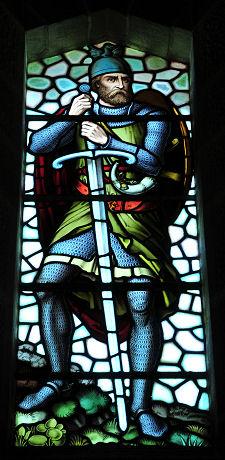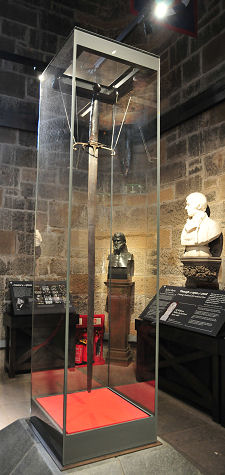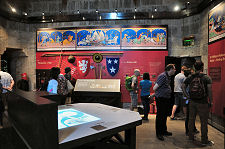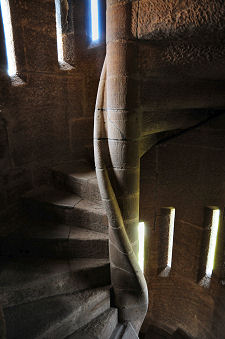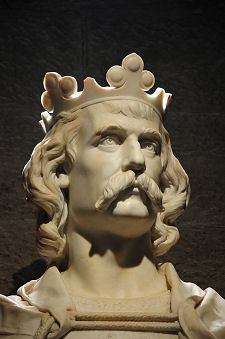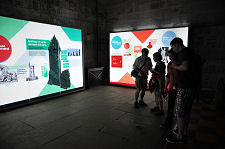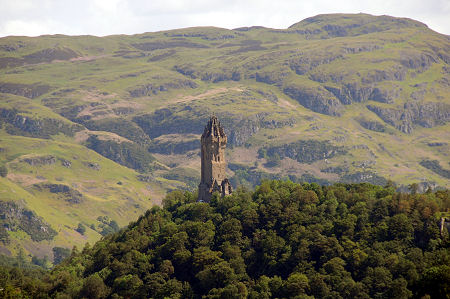 The National Wallace Monument and the Ochils from Stirling Castle |
Most cities would be very happy to have a skyline as distinctive as Stirling's. It is home to two world famous landmarks, each in its own way is a reminder of Scotland's long and often bloody history. High on an outcrop of volcanic rock on the south side of the plain of the looping River Forth stands the magnificent Stirling Castle. Standing even higher on its own outcrop of volcanic rock on the north side of the river is The National Wallace Monument. Whatever your direction of approach to Stirling you cannot fail to be impressed by one or the other, or both, of these features: with the castle, spreading across its rock like a sleeping lion, providing a perfect counterpoint to the visually striking exclamation mark of the Wallace Monument.
The National Wallace Monument commemorates Sir William Wallace. You can read a fuller account of his life here, but in essence he was one of the very few who consistently opposed the efforts of King Edward I of England to impose his will, and ultimately his supremacy, over Scotland and the Scots in the years around 1300.
The Wallace, as he is often known, is one of the most powerful, most evocative, and most well recognised figures from Scottish history. It is a fair bet that today his name is better known worldwide than most, if not all, of Scotland's monarchs.
Yet he was never a king; his notable deeds took place over a very short period of time, part of which he actually spent in France; he fought just two major battles and emerged with a score of won one and lost one; he resigned from his job; and in the end he was betrayed and executed. The wider picture in Scotland at the time is set out in our Historical Timeline.
There's a contradiction here. Behind it lies the stunningly good press that William Wallace has received over the centuries. Most notably, the bard Blind Harry wrote an epic 1470 poem, The Acts and Deeds of Sir William Wallace, Knight of Elderslie. This introduced the story of Wallace as the heroic figure we now all know, at times without too much regard for the actual historical facts.
But it was not Blind Harry who brought Wallace's story to the attention of a worldwide audience, it was Mel Gibson. His 1995 film Braveheart added another layer of artistic license to the one already applied by Blind Harry. The result has been criticised for its lack of historical accuracy. But critics of what is, without doubt, a superbly entertaining and enormously popular film, miss the point. The point is that the historical accuracy of the film doesn't really matter, just as the historical accuracy of Blind Harry's poem didn't really matter. People believe what they want to believe, and for a nation in search of national heroes, William Wallace fitted the bill perfectly: and still does.
But let's wind the story back to the mid-1800s. Scotland, with more than a little help from Sir Walter Scott, was going through an earlier phase of the rediscovery of its sense of national pride and identity after a period during which for many it had become "North Britain". Blind Harry's William Wallace was a perfect focus for the celebration of this new sense of identity and as a result statues of him and monuments to him began to spring up all over the country, with more than 20 being built in all.
But many wanted a national monument to William Wallace that could be venerated by everyone in Scotland. Funds were raised from the public, and a competition was launched for a design for the monument after an initial proposal was deemed too anti-English (of a Scottish lion in the act of killing a mythical English creature). 106 entries were submitted and the design that was selected was by the Scots Baronial architect J.T. Rochead.
His approach was to marry together two uniquely Scottish features. He took the traditional design of a Scottish tower house castle, complete with an external stair turret, and stretched it vertically. Then he added to the top a stone crown spire, of the sort seen atop the towers of St Giles' Cathedral in Edinburgh and King's College in Aberdeen.
The question of location had been decided some years earlier. Both Edinburgh and Glasgow wanted to be home to the monument, and Stirling was chosen mainly because it could be seen as neutral territory. Having decided on Stirling, the choice of the rocky outcrop of Abbey Craig was an obvious one for the monument, for three main reasons. Firstly, if you are going to build a monument intended to make a statement, putting it on top of a high outcrop of rock allows it to make the biggest statement possible. Secondly, Abbey Craig could be quarried to provide the stone needed to build the monument.
The third reason for the location was that Abbey Craig overlooks the site of William Wallace's most notable victory over the English, the Battle of Stirling Bridge, which took place on 11 September 1297. This was fought around the original wooden bridge over the River Forth at Stirling, in the shadow of Stirling Castle and just below Abbey Craig. The original bridge lay a short distance upstream from the stone bridge known today as Old Stirling Bridge. The Scots attacked from the Abbey Craig when the English were half deployed across the bridge and won an overwhelming victory. After the battle, Wallace was knighted by an unnamed Earl and became Sir William Wallace "Guardian of the Kingdom of Scotland and leader of its armies." His co-leader, Andrew Murray fared less well, dying some time later from wounds received during the battle. Wallace followed up the victory by leading the Scots into Northumberland and Cumbria, retreating only when the weather became too bad to continue the campaign.
The true historical significance of the Battle of Stirling Bridge is debatable. The English returned to Scotland in early 1298, trying to draw Wallace into open battle. This eventually happened at the Battle of Falkirk, on 22 July 1298. Defeat there was the beginning of the end for Wallace who was eventually executed in London on 23 August 1305. But as we've already said, none of this is really about history: the myth of Wallace has a life of its own that remains hugely influential.
The National Wallace Monument you see today was completed in 1869 after eight years' construction. It stands some 220ft or 67m high, and Abbey Craig adds a further 300ft or 91m, meaning that the top of the monument stands 520ft above the (tidal) River Forth below. You start your visit in the attractive visitor centre, shop and cafe next to the car park at the foot of the Abbey Craig. From here you can follow the path to the monument itself, remembering that it is a 300ft climb, or use the monument's own minibus service.
From the top of Abbey Craig, views of the monument itself are obviously foreshortened. It is worth looking out for the Wallace Statue, set into a corner of the monument. It's difficult to appreciate the true scale of the statue, which was added in 1887, but it is a 4m or 13ft tall bronze weighing some three tons. It is a slight hint of "what might have been": an early proposal for the monument had been for a colossal statue of Wallace, on the scale of New York's Statue of Liberty.
In the ground floor of the monument is a reception area, a shop, and a nice little lounge with a vending machine that sells cold drinks: especially welcome to anyone who has climbed Abbey Craig on a hot day. But you will probably want to head straight for the magnificent views awaiting at the top of the monument, a mere 220 feet and 246 steps above you. Most of the steps are enclosed within the corner stair turret and describe a fairly narrow spiral, which can make passing those heading in the opposite direction interesting.
The Monument has four levels above the ground floor, with Level 4 being The Crown or the top. The first 71 steps up to Level 1 bring you to the Hall of Arms, with displays of arms, information about the story of William Wallace and the Battle of Stirling Bridge.
64 more steps will bring you to Level 2 and the Hall of Heroes. Here are displayed marble statues of notable Scotsmen, the result of a worldwide appeal by the custodians in 1885. Also on display is what is said to be the 700 year old Wallace sword, some 5 feet 4 inches long. Coming face to face with such a magnificent piece of metalwork you wonder how anyone could have lifted or carried it, still less fought with it. This level is also a good place to appreciate some of the monument's magnificent collection of eleven stained glass windows
62 steps further lead to Level 3, the Royal Chamber, and a series of illuminated panels giving the background to the monument itself. The final pull leads to The Crown of the Monument with its breathtaking views which make every one of those 246 steps worthwhile.
To the north you are immediately struck by the closest of the Ochil Hills, Dumyat. To the east is the Forth Valley, with the river itself snaking away into the distance. To the south is the historic city of Stirling, dominated by its Castle. To the west are the Trossachs and Loch Lomond and, on a clear day, a far-reaching panorama of many of the southern highlands' most striking mountains.
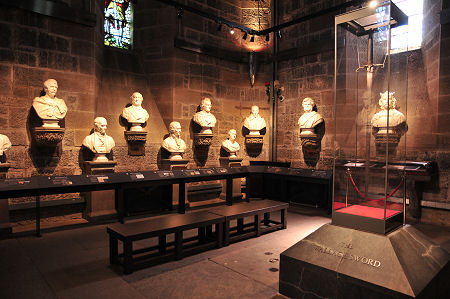 The Hall of Heroes and the Wallace Sword |

|
|
|
Visitor InformationView Location on MapSTB 4 Star Visitor Attraction. The National Wallace Monument, Abbey Craig, Hillfoots Road, Causewayhead, Stirling FK9 5LF. Tel: 01786 472140. info@ nationalwallacemonument.com Grid Ref: NS 809 956 Web Site Opening hours Admission Accessibility What3Words Location: ///dreams.giants.safely |
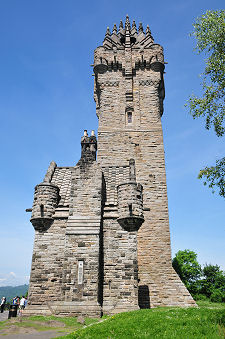 The Monument from the South |
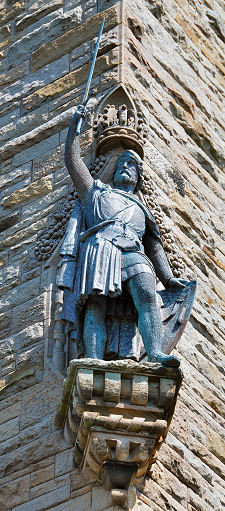 The Wallace Statue |
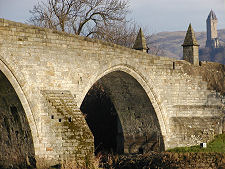 Monument from Old Stirling Bridge |
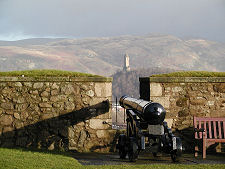 The Monument from Stirling Castle |
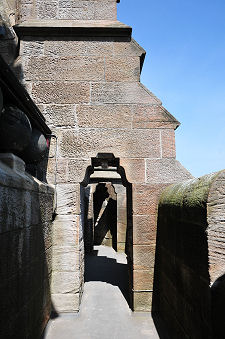 Lower Level of the Crown |
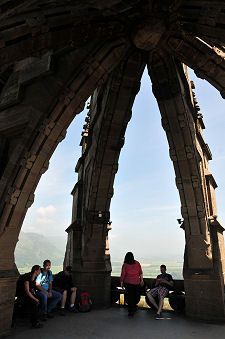 Upper Level of the Crown |
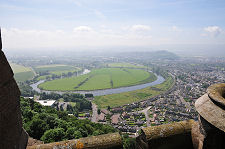 Stirling Castle and the River Forth |
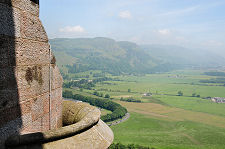 The Ochil Hills |
